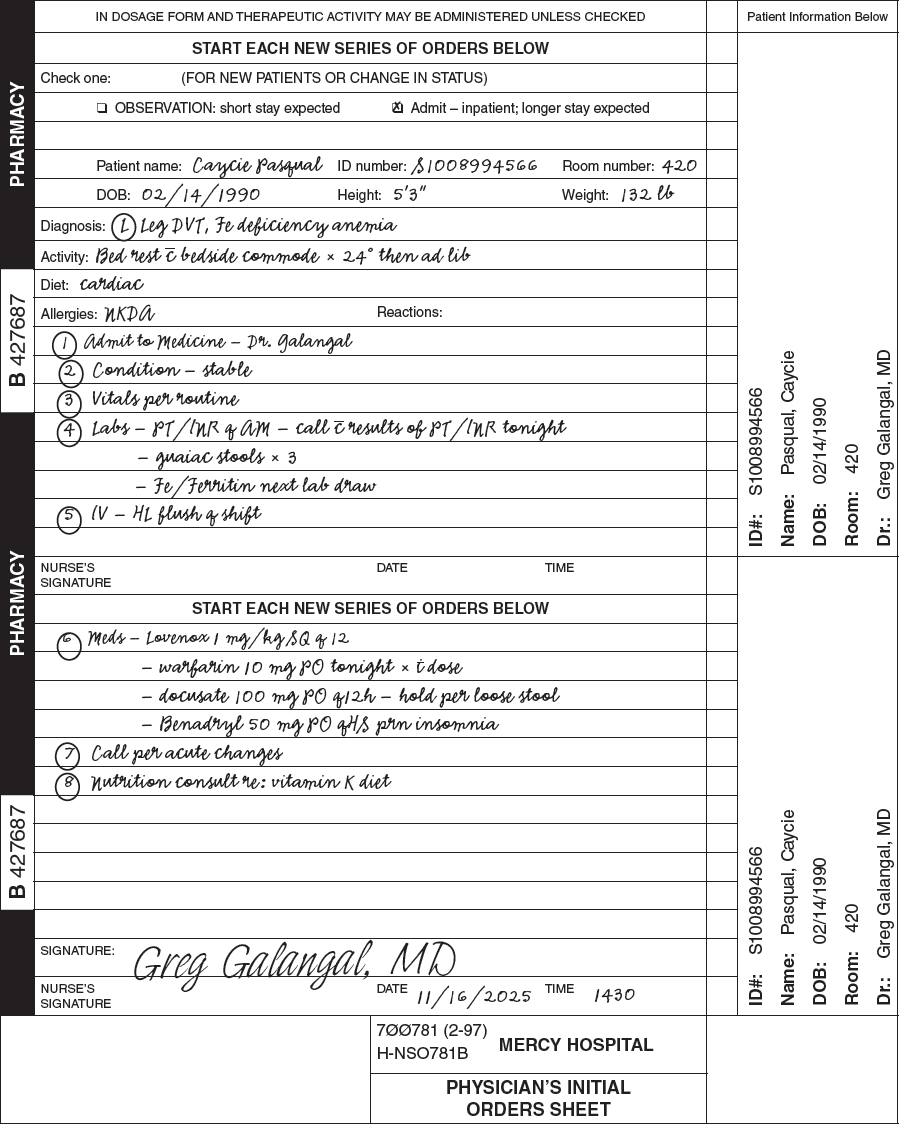3.4 Interpretation of Prescriptions and Medication Orders
With a good understanding of the types and components of prescriptions and medication orders as well as a familiarity with medical abbreviations, acronyms, and symbols, you are ready to assimilate this information. To do so, you need to practice the correct interpretation of prescriptions and medication orders so that you can perform accurate pharmacy calculations in the pharmacy setting. Honing these skills is an important responsibility of pharmacy technicians and is critical to the safe dispensing of medications to patients.
Interpreting Prescriptions
Whether prescriptions are written, faxed, or communicated via a phone or a digital device, you must be able to accurately interpret the information these orders contain. Patient information, prescriber information, and medication information must be readily identified and transcribed, if necessary. The use of medical abbreviations, acronyms, and symbols must be translated as well. The interpretation of this information may lead to subsequent pharmacy calculations such as days’ supply and quantity to dispense. The following example will apply the literacy skills of this chapter into the interpretation of a prescription.
Example 3.4.1
Review the following prescription and answer the associated questions.
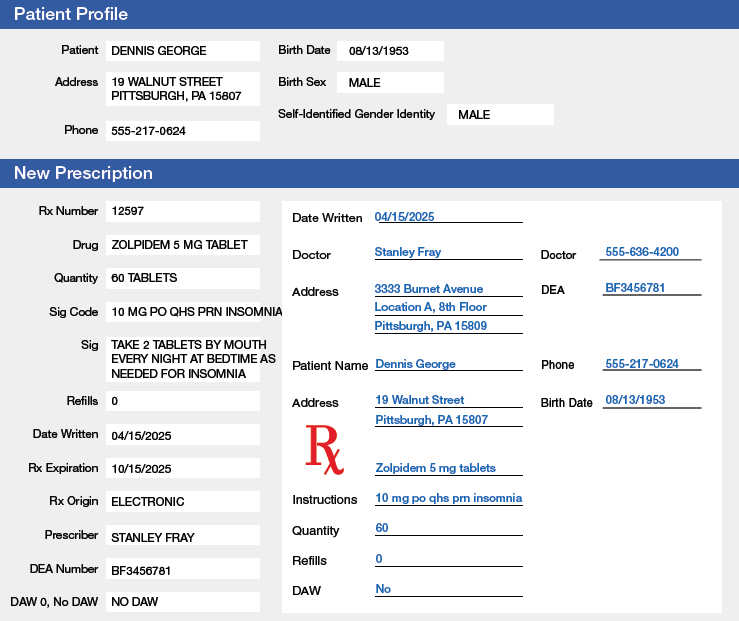
Which type of prescription is pictured?
Answer: This screen capture depicts an electronic prescription (e-prescription).
What is the patient’s name on this prescription?
Answer: The patient’s name is Dennis George.
What is the prescriber’s name on this prescription?
Answer: The prescriber’s name is Stanley Fray.
What is the prescriber’s DEA number?
Answer: The prescriber’s DEA number is BF3456781.
Could the prescriber’s DEA be valid? Utilize the DEA check digit verification process to support your answer.
To begin, review the letters of the DEA number. The first letter matches the prescriber’s level of authority (the letters A, B, or F for a primary practitioner). The second letter matches the first initial of the prescriber’s last name (the letter F).
Next, utilize the DEA check digit verification process to determine potential validity of the number.
Step 1
Add the first, third, and fifth digits of the DEA number.
3 + 5 + 7 = 15
Step 2
Add the second, fourth, and sixth digits of the DEA number.
4 + 6 + 8 = 18
Step 3
Multiply the sum obtained in Step 2 by 2.
18 × 2 = 36
Step 4
Add the results of Steps 1 and 3. The last digit of this sum or the checksum, should match the check digit, the last digit of the prescriber’s DEA number (the number 1).
15 + 36 = 51
Answer: The prescriber’s DEA number could be valid.
What drug, strength, and quantity are listed on the inscription and the subscription?
Recall that the inscription is the part of the prescription that lists the medication prescribed. The subscription lists instructions to the pharmacist.
Answer: The inscription on this e-prescription is for zolpidem tablets. The strength is 5 mg. The quantity to dispense is 60 tablets.
Which label indicates the medication needed to fill the prescription?
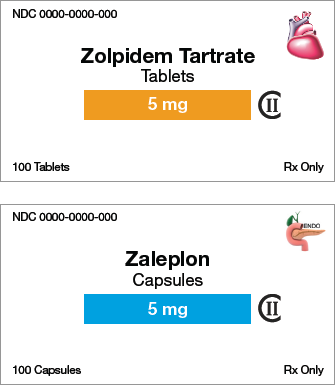
Answer: The medication labeled as zolpidem 5 mg (pictured on top) should be selected.
What directions for use are listed in the signa (sig)? Please translate any abbreviations into language that the patient would understand. Then determine the quantity of medication needed for each dose.
To begin, find the sig on the e-prescription. The sig states 10 mg po qhs prn insomnia.
Next, translate the sig into language that the patient would understand. The abbreviation po means “by mouth,” and the abbreviation qhs means “every night at bedtime.” The abbreviation prn means “as needed for.” The sig 10 mg po qhs prn insomnia translates to “10 mg by mouth every night at bedtime as needed for insomnia.”
Now, using the dimensional analysis method, set up an equation with the information from the e-prescription: the prescribed drug’s strength (5 mg/tablet) and its dose (10 mg/dose). Then cancel like units to determine the number of tablets needed for each dose.

Answer: The sig states 10 mg po qhs prn insomnia, which is translated to “10 mg by mouth every night at bedtime as needed for insomnia.” The patient will need 2 tablets by mouth for every dose.
If the patient takes the medication every night, what is the days’ supply of this prescription?
Recall that days’ supply is the number of days that a prescription medication will last a patient when taken as directed. In this example, two tablets are needed for each dose, and one dose is taken per day. To calculate days’ supply, you can solve this problem by using the ratio-proportion method or by using the dimensional analysis method.
Ratio-Proportion Method
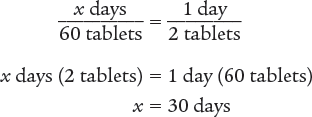
Dimensional Analysis Method
Set up your dimensional analysis using the information provided. Then cancel like units (in this case, “tablets”) and multiply.

Answer: The days’ supply of the prescription is 30 days.
How many refills are indicated on the prescription?
Answer: The subscription indicates that no refills are allowed.
Interpreting Medication Orders
As discussed earlier, a pharmacy receives different types of medication orders either electronically or in written form. As a pharmacy technician, you must be able to accurately identify and interpret the patient, prescriber, and medication information these orders contain. You must also be able to convert 24-hour time to standard time for patient ease and understanding. The following example will apply the literacy skills of this chapter to the interpretation of a medication order.
Example 3.4.2
Review the medication order and answer the associated questions.
Which type of medication order is shown here?
Answer: This order is a daily medication order.
What is the patient’s name?
Answer: The patient’s name is Heidi McCarthy.
What allergies or sensitivities does the patient have?
Answer: The patient has no known allergies.
What is the patient’s weight and height?
Answer: The patient’s weight is 186 lb, and the patient’s height is 5’7".
What is the prescriber’s name?
Answer: The prescriber’s name is Yuka Sun.
What is the prescriber’s authority?
Answer: The prescriber is an MD, or medical doctor.
On what date was the medication order written?
Answer: The medication order was written on 06/24/2025.
What time was the medication order written? Please state your answer in 24-hour time and in standard time.
Answer: The medication order was written at 1800, which is 24-hour time. To convert the 24-hour time to standard time, subtract 1200 from 1800. The standard time for this order is 6:00 p.m.
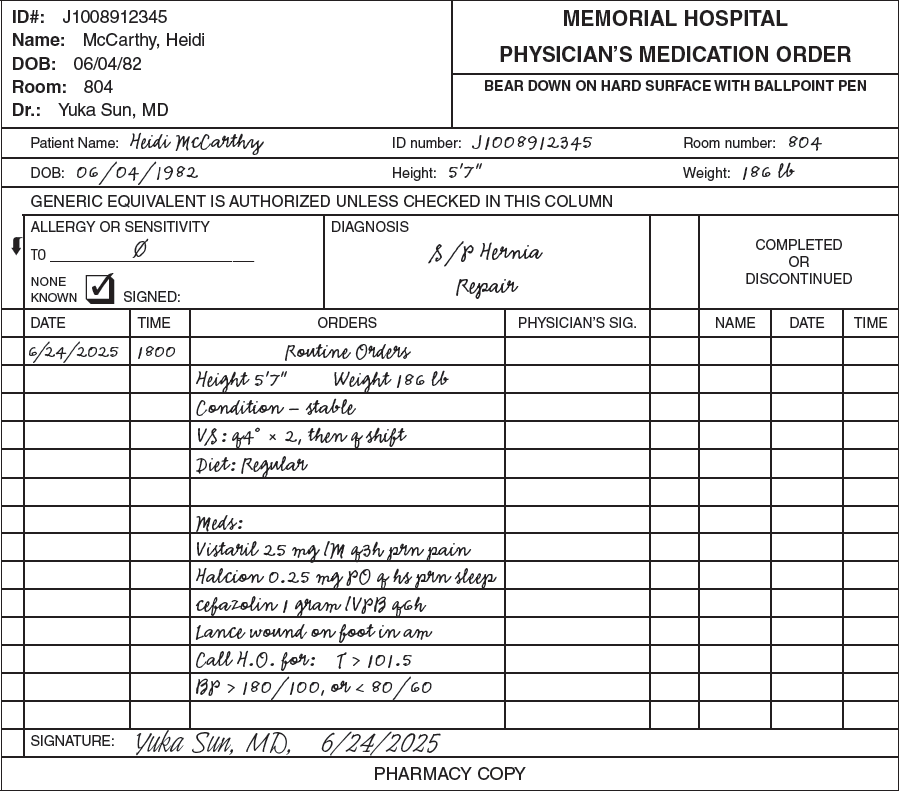
What drugs, strengths, routes of administration, and frequencies of administration are listed on the medication order? Please translate any abbreviations or acronyms.
The “Meds” section of the order prescribes the following medications for the patient:
Vistaril 25 mg IM q3h prn pain, which translates to “Vistaril 25 mg intramuscularly every 3 hours as needed for pain”
Halcion 0.25 mg PO qhs prn sleep, which translates to “Halcion 0.25 mg by mouth every night at bedtime as needed for sleep”
Cefazolin 1 gram IVPB q6h, which is translated to “cefazolin 1 gram by intravenous piggyback every 6 hours”
Answer: The prescriber has ordered Vistaril 25 mg intramuscularly every 3 hours as needed for pain, Halcion 0.25 mg by mouth every night at bedtime as needed for sleep, and cefazolin 1 gram by intravenous piggyback every 6 hours.
If the patient’s first dose of cefazolin is at 0800, when should the second and third doses be administered? Include 24-hour time and standard time in your answer.
Answer: If the patient takes the first dose of cefazolin at 0800 (8:00 a.m.) and is to take the medication every 6 hours, the patient will take the second dose at 1400 (2:00 p.m.) and the third dose at 2000 (8:00 p.m.).
3.4 Problem Set
Review the following prescription and answer the associated questions.

Which type of prescription is shown here?
What is the patient’s name?
What is the prescriber’s name?
What is the prescriber’s DEA number?
Determine the validity of the DEA number by verifying the prescriber identifiers and using the check digit verification process.
What drug, dosage form, and strength are listed on the inscription?
Which label indicates the medication needed to fill the prescription?
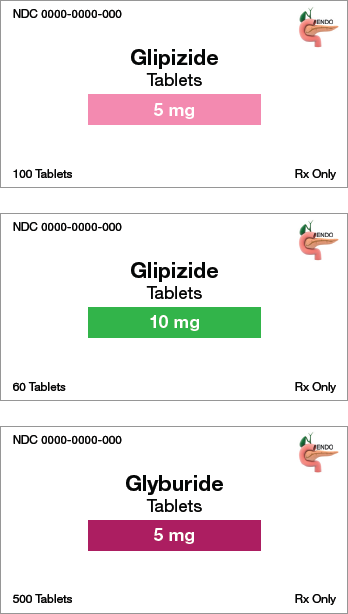
What directions for use are listed on the signa (sig)? Translate any abbreviations into language that the patient would understand. (If you need additional support to complete this exercise, refer to Appendix B: Common Pharmacy Abbreviations and Acronyms in this textbook.)
What is the days’ supply of this prescription? What is the quantity to dispense?
How many refills are indicated on the prescription?
Review the medication order on the following page and answer the associated questions.
Which type of medication order is shown here?
What is the patient’s name?
What allergies or sensitivities does the patient have?
What is the patient’s height and weight?
What is the prescriber’s name?
What is the prescriber’s authority?
What date was the medication order written?
What time was the medication order written? Include both 24-hour time and standard time in your answer.
What drugs, strengths, routes of administration, and frequencies of administration are listed on the medication order? Translate any abbreviations or acronyms. (If you need additional support to complete this exercise, refer to Appendix B: Common Pharmacy Abbreviations and Acronyms in this textbook.)
If the patient’s first dose of docusate is at 0800, when should the patient’s second dose be administered? Include both 24-hour time and standard time in your answer.
Self-check your work in Appendix A.
